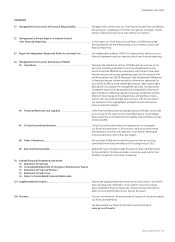GE 2011 Annual Report Download - page 41
Download and view the complete annual report
Please find page 41 of the 2011 GE annual report below. You can navigate through the pages in the report by either clicking on the pages listed below, or by using the keyword search tool below to find specific information within the annual report.’
GE 2011 ANNUAL REPORT 39
Global Risk Management
A disciplined approach to risk is important in a diversifi ed organi-
zation like ours in order to ensure that we are executing according
to our strategic objectives and that we only accept risk for which
we are adequately compensated. We evaluate risk at the indi-
vidual transaction level, and evaluate aggregated risk at the
customer, industry, geographic and collateral-type levels,
where appropriate.
Risk assessment and risk management are the responsibility
of management. The GE Board of Directors (Board) has oversight
for risk management with a focus on the most signifi cant risks
facing the Company, including strategic, operational, fi nancial and
legal and compliance risks. At the end of each year, management
and the Board jointly develop a list of major risks that GE plans to
prioritize in the next year. Throughout the year, the Board and the
committees to which it has delegated responsibility dedicate a
portion of their meetings to review and discuss specifi c risk top-
ics in greater detail. Strategic, operational and reputational risks
are presented and discussed in the context of the CEO’s report
on operations to the Board at regularly scheduled Board meet-
ings and at presentations to the Board and its committees by the
vice chairmen, Chief Risk Offi cer (CRO), general counsel and other
employees. The Board has delegated responsibility for the over-
sight of specifi c risks to Board committees as follows:
• In 2011, the Board established a Risk Committee. This
Committee oversees GE’s risk management of key risks,
including strategic, operational (including product risk), fi nan-
cial (including credit, liquidity and exposure to broad market
risk) and reputational risks, and the guidelines, policies and
processes for monitoring and mitigating such risks. Starting
in 2011, as part of its overall risk oversight responsibilities for
GE, the Risk Committee also began overseeing risks related
to GE Capital, which previously was subject to direct Audit
Committee oversight.
• The Audit Committee oversees GE’s and GE Capital’s policies
and processes relating to the fi nancial statements, the fi nan-
cial reporting process, compliance and auditing. The Audit
Committee monitors ongoing compliance issues and matters,
and also annually conducts an assessment of compliance
issues and programs.
• The Public Responsibilities Committee oversees risk manage-
ment related to GE’s public policy initiatives, the environment
and similar matters, and monitors the Company’s environ-
mental, health and safety compliance.
• The Management Development and Compensation
Committee oversees the risk management associated with
management resources, structure, succession planning, man-
agement development and selection processes, and includes
a review of incentive compensation arrangements to confi rm
that incentive pay does not encourage unnecessary risk taking
and to review and discuss, at least annually, the relationship
between risk management policies and practices, corporate
strategy and senior executive compensation.
• The Nominating and Corporate Governance Committee over-
sees risk related to the Company’s governance structure and
processes and risks arising from related-person transactions.
The GE Board’s risk oversight process builds upon management’s
risk assessment and mitigation processes, which include stan-
dardized reviews of long-term strategic and operational planning;
executive development and evaluation; code of conduct compli-
ance under the Company’s The Spirit & The Letter; regulatory
compliance; health, safety and environmental compliance; fi nan-
cial reporting and controllership; and information technology and
security. GE’s CRO is responsible for overseeing and coordinating
risk assessment and mitigation on an enterprise-wide basis. The
CRO leads the Corporate Risk Function and is responsible for the
identifi cation of key business risks, providing for appropriate
management of these risks within GE Board guidelines, and
enforcement through policies and procedures. Management has
two committees to further assist it in assessing and mitigating
risk. The Corporate Risk Committee (CRC) meets periodically, is
chaired by the CRO and comprises the Chairman and CEO, vice
chairmen, general counsel and other senior level business and
functional leaders. It has principal responsibility for evaluating
and addressing risks escalated to the CRO and Corporate Risk
Function. The Policy Compliance Review Board met 15 times in
2011, is chaired by the Company’s general counsel and includes
the Chief Financial Offi cer and other senior level functional lead-
ers. It has principal responsibility for monitoring compliance
matters across the Company.
GE’s Corporate Risk Function leverages the risk infrastructures
in each of our businesses, which have adopted an approach that
corresponds to the Company’s overall risk policies, guidelines and
review mechanisms. Our risk infrastructure operates at the busi-
ness and functional levels and is designed to identify, evaluate
and mitigate risks within each of the following categories:
•
STRATEGIC. Strategic risk relates to the Company’s future
business plans and strategies, including the risks associated
with the markets and industries in which we operate, demand
for our products and services, competitive threats, technol-
ogy and product innovation, mergers and acquisitions and
public policy.
•
OPERATIONAL. Operational risk relates to risks (systems, pro-
cesses, people and external events) that affect the operation
of our businesses. It includes product life cycle and execution,
product safety and performance, information management
and data protection and security, business disruption, human
resources and reputation.
•
FINANCIAL. Financial risk relates to our ability to meet fi nancial
obligations and mitigate credit risk, liquidity risk and exposure
to broad market risks, including volatility in foreign currency
exchange rates and interest rates and commodity prices.
Liquidity risk is the risk of being unable to accommodate
liability maturities, fund asset growth and meet contractual
























